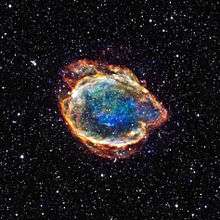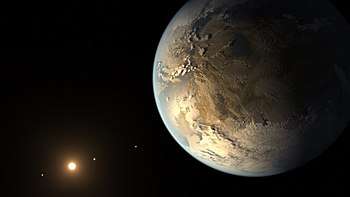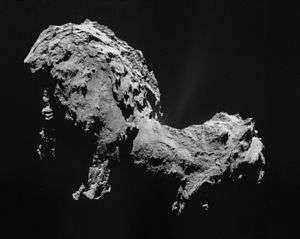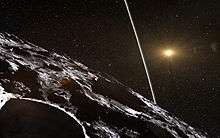SN 2014J
SN 2014J was a type-Ia supernova in Messier 82 (the 'Cigar Galaxy', M82) discovered in mid-January 2014.[2] It was the closest type-Ia supernova discovered for 42 years, and none have been closer as of 2018. The supernova was discovered by chance during an undergraduate teaching session at the University of London Observatory. It peaked on 31 January 2014, reaching an apparent magnitude of 10.5.[3] SN 2014J was the subject of an intense observing campaign by professional astronomers and was bright enough to be seen by amateur astronomers.
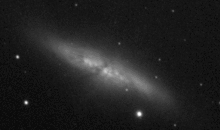 First image: Messier 82 on 10 December 2013. Second image: The same view on 22 January 2014. The position of the supernova is marked. | |
| Other designations | SN 2014J |
|---|---|
| Event type | Supernova |
| Spectral class | Type Ia, SN.Ia |
| Date | 21 January 2014 |
| Instrument | UCL Observatory |
| Constellation | Ursa Major |
| Right ascension | 9h 55m 42.217s[1] |
| Declination | 69° 40′ 26.56″[1] |
| Epoch | J2000 |
| Distance | 11,500,000 ly (3,500,000 pc) |
| Host | Messier 82 |
| Progenitor | unknown |
| Notable features | Closest Type Ia for 40 years |
Discovery
The supernova was discovered by astronomer Steve Fossey, of University College London. Fossey was training four undergraduate students (Ben Cooke, Guy Pollack, Matthew Wilde and Thomas Wright) to use a small 0.35-metre (14 in) telescope at University of London Observatory, located in Mill Hill, north London.[4][5][6]
The discovery was serendipitous, because Fossey was not searching for supernovae, had not planned to look at M82, and only wanted to take advantage of a short gap in the London cloud cover. He later said that "The weather was closing in, with increasing cloud, so instead of the planned practical astronomy class, I gave the students an introductory demonstration of how to use the CCD camera on one of the observatory’s automated 0.35–metre telescopes."[5]
At 19:20 GMT on 21 January 2014, Fossey and his students noticed a bright new star in their images of the galaxy Messier 82, also known as the Cigar Galaxy.[5] After comparing their image to archival ones of the same galaxy, they used observations with a second telescope to eliminate the possibility of an instrumental artefact.[6] Their discovery was reported to the International Astronomical Union's Central Bureau for Astronomical Telegrams, who confirmed that they were the first to spot the supernova and assigned it the name SN 2014J as the tenth supernova discovered in 2014.[5]
Observations

Follow-up adaptive optics observations with the 10-metre (390 in) Keck telescope at Mauna Kea Observatory, Hawaii were used to precisely determine the location of the new supernova.[1] The first optical spectrum was obtained using the 3.5-metre (140 in) ARC telescope in New Mexico, which showed the supernova to be of Type Ia.[8] Pre-discovery recovery images were found that showed the supernova as early as 15 January, six days before discovery.[9]
Early indications were that the supernova had been discovered approximately 14 days before maximum light, so it would get brighter over the following fortnight.[8] It was predicted to be bright enough to be visible with binoculars throughout the Northern Hemisphere.[4] The supernova continued to get brighter until 31 January, when it peaked at an apparent magnitude of 10.5.[3]
SN 2014J was a popular target for amateur astronomers because it was located close to The Plough asterism (the 'Big Dipper') and visible all night for most Northern Hemisphere observers.[10][11]
Its unusual brightness and relative closeness led to SN 2014J becoming the subject of intense follow-up observations by astronomers worldwide,[6] including with the Hubble Space Telescope.[12] Over 250 scientific papers have discussed the supernova.[13][14]
Physical properties
The relative closeness of the supernova allowed astronomers to study it in much more detail than usual. Type Ia supernovae are especially important as standard candles in physical cosmology, and astronomers hope that SN 2014J will help them understand how these supernovae form and evolve.[6]
SN2014J was observed by the INTErnational Gamma-Ray Astrophysics Laboratory (INTEGRAL) which detected the gamma-ray spectral lines characteristic of the radioactive decay chain 56Ni→56Co→56Fe.[15] This was the first time these lines were detected in a Type Ia supernova, providing support for the standard model that this class of supernova produces large quantities of 56Ni through nucleosynthesis.[16]
Observations of the diffuse interstellar bands in the spectrum of the supernova indicated that it lay behind a significant quantity of interstellar medium in M82. The supernova therefore suffered from interstellar extinction, with a reddening of at least one magnitude.[17] The degree of light extinction from M82 dust blocking SN 2014J reduces its value as an observational prototype for Type Ia supernovae, but makes it a powerful probe of the interstellar medium of M82.[18]
Researchers used archival images from the Hubble Space Telescope to study the environment of SN 2014J prior to the supernova, hoping to identify the progenitor system,[19] but found no identifiable progenitor star.[20] This is not unexpected, because the progenitors of type Ia supernovae are thought to be white dwarfs in binary systems,[21] and observation of SN 2014J provided empirical confirmation for this.[22] The white dwarf is much too faint to detect at the distance of M82, but its companion would have been detectable if it had been a bright evolved giant star. It will however remain too faint if it is a second white dwarf (the double degenerate Type Ia supernova path), a lower main-sequence star, or even a giant star on the fainter part of the giant sequence.
Distance
At a distance of 11.5 ± 0.8 million light-years (3.5 ± 0.3 megaparsecs),[23] SN 2014J was one of the closest supernovae seen for decades. It was the closest type Ia supernova since SN 1972E,[10] and the closest supernova of any type since 2004. Some sources initially stated that SN 2014J was the closest supernova of any type since SN 1987A,[4] but this claim is erroneous.[10] The last supernova that was unambiguously closer to Earth than SN 2014J was SN 2004dj, a type II-P supernova in the galaxy NGC 2403, 8 million light-years from Earth. SN 1993J was a type IIb supernova at almost the same distance as SN 2014J, because it was located in Messier 81, which together with Messier 82 and NGC 3077 forms the core of the M81 group of galaxies.[5]
References
- Tendulkar, S. P.; Liu, M. C.; Dupuy, T. J.; Ca, Y. (23 January 2014). "Near-IR Adaptive Optics Localization of PSN J09554214+6940260". The Astronomer's Telegram. 5789: 5789. Bibcode:2014ATel.5789....1T. Retrieved 23 January 2014.
- "Supernova SN 2014J". Observation Logbook. Carleton University. 22 January 2014. Archived from the original on 1 February 2014. Retrieved 27 January 2014.
This is the closest type Ia supernova observed in the last 40 years.
- Alan MacRobert (17 February 2014). "Supernova in M82 Passes Its Peak - Sky & Telescope". Skyandtelescope.com.
- "Nearby supernova dazzles astronomers". BBC News. 23 January 2014. Retrieved 23 January 2014.
the closest supernova to Earth that has been seen in decades
- "Supernova in Messier 82 discovered by UCL students" (Press release). University College London. 22 January 2014.
- Lucas, Laursen (22 January 2014). "Supernova erupts in nearby galaxy". Nature News. doi:10.1038/nature.2014.14579. Retrieved 23 January 2014.
- "Light Echo around SN 2014J in M82". www.spacetelescope.org. Retrieved 15 November 2017.
- Cao, Y.; Kasliwal, M. M.; McKay, A.; Bradley, A. (22 January 2014). "Classification of Supernova in M82 as a young, reddened Type Ia Supernova". The Astronomer's Telegram. 5786: 5786. Bibcode:2014ATel.5786....1C. Retrieved 23 January 2014.
- Ma, Bin; Wei, Peng; Shang, Zhaohui; Wang, Lifan; Wang, Xiaofeng (23 January 2014). "Prediscovery Observations of SN 2014J in M82 from the Antarctic Survey Telescope". The Astronomer's Telegram. 5794: 5789. Bibcode:2014ATel.5794....1M. Retrieved 23 January 2014.
- MacRobert, Alan (22 January 2014). "Bright Supernova in M82". Sky & Telescope. Retrieved 27 January 2014.
this is said to be the nearest supernova since 1972 of Type Ia
- King, Bob (22 January 2014). "Bright New Supernova Blows Up in Nearby M82, the Cigar Galaxy". Universe Today. Retrieved 23 January 2014.
- Foley, Ryan (24 January 2014). "HST Observations of SN 2014J". The Astronomer's Telegram. 5811: 5789. Bibcode:2014ATel.5811....1F. Retrieved 25 January 2014.
- "ADS results for SN 2014J". NASA Astrophysics Data System. Retrieved 13 September 2019.
- "SN 2014J bibliography". SIMBAD. Centre de données astronomiques de Strasbourg. Retrieved 13 September 2019.
- Churazov, E.; Sunyaev, R.; Grebenev, S.; Isern, J.; Jean, P.; Knodlseder, J.; Lebrun, F.; Renaud, M.; Bravo, E.; Diehl, R.; Kuulkers, E. (20 March 2014). "Detection of the 847 keV gamma-ray line of radio-active Co56 from the Type Ia Supernova SN2014J in M82 with INTEGRAL". The Astronomer's Telegram. 5992: 5992. Bibcode:2014ATel.5992....1C. Retrieved 20 March 2014.
- Churazov, E.; Sunyaev, R.; Isern, J.; Knödlseder, J.; Jean, P.; Lebrun, F.; Chugai, N.; Grebenev, S.; Bravo, E. (2014). "Cobalt-56 γ-ray emission lines from the type Ia supernova 2014J". Nature. 512 (7515): 406–408. arXiv:1405.3332. Bibcode:2014Natur.512..406C. doi:10.1038/nature13672. PMID 25164750.
- Cox, Nick; Davis, P.; Patat, F.; Van Winckel, Hans (23 January 2014). "High-resolution spectroscopy of SN2014J in M82". The Astronomer's Telegram. 5797: 5789. Bibcode:2014ATel.5797....1C. Retrieved 25 January 2014.
- Ritchey, Adam M.; Welty, Daniel E.; Dahlstrom, Julie A.; York, Donald G. (2015). "Diffuse Atomic and Molecular Gas in the Interstellar Medium of M82 toward SN 2014J". The Astrophysical Journal. 799 (2): 197. arXiv:1407.5723. Bibcode:2015ApJ...799..197R. doi:10.1088/0004-637X/799/2/197.
- Goobar, A; Johansson, J; Amanullah, R; Cao, Y; Perley, D. A; Kasliwal, M. M; Ferretti, R; Nugent, P. E; Harris, C; Gal-Yam, A; Ofek, E. O; Tendulkar, S. P; Dennefeld, M; Valenti, S; Arcavi, I; Banerjee, D. P. K; Venkataraman, V; Joshi, V; Ashok, N. M; Cenko, S. B; Diaz, R. F; Fremling, C; Horesh, A; Howell, D. A; Kulkarni, S. R; Papadogiannakis, S; Petrushevska, T; Sand, D; Sollerman, J; et al. (2014). "The Rise of Sn 2014J in the Nearby Galaxy M82". The Astrophysical Journal. 784 (1): L12. arXiv:1402.0849. Bibcode:2014ApJ...784L..12G. doi:10.1088/2041-8205/784/1/L12.
- Kelly, Patrick L.; Fox, Ori D.; Filippenko, Alexei V.; Cenko, S. Bradley; et al. (2014). "Constraints on the Progenitor System of the Type Ia Supernova 2014J from Pre-Explosion Hubble Space Telescope Imaging". The Astrophysical Journal. 790 (1): 3. arXiv:1403.4250. Bibcode:2014ApJ...790....3K. doi:10.1088/0004-637X/790/1/3.
- Mazzali; Röpke; Benetti; Hillebrandt (2007). "A Common Explosion Mechanism for Type Ia Supernovae". Science. 315 (5813): 825–828. arXiv:astro-ph/0702351. Bibcode:2007Sci...315..825M. doi:10.1126/science.1136259. PMID 17289993.
- Drake, Nadia (28 August 2014). "Type 1a Supernovae: Why Our Standard Candle Isn't Really Standard". National Geographic.
- Karachentsev, I. D.; Kashibadze, O. G. (2006). "Masses of the local group and of the M81 group estimated from distortions in the local velocity field". Astrophysics. 49 (1): 3–18. Bibcode:2006Ap.....49....3K. doi:10.1007/s10511-006-0002-6.

